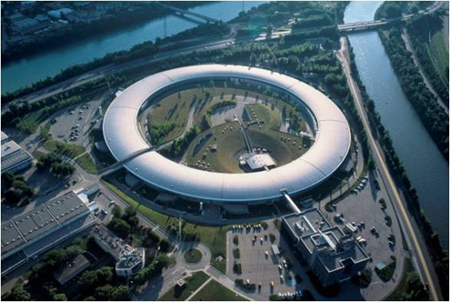The XMaS facility, at the European Synchrotron Radiation (ESRF) in France, is owned by the University of Liverpool and University of Warwick
The University of Liverpool’s world-leading x-ray magnetic scattering (XMaS) facility has been awarded £6million funding to continue its study of the microscopic and atomic structure of matter.
The facility, has received funding from the Department of Business, Innovation and Skills and the Engineering and Physical Sciences Research Council (EPSRC) to further study into the atomic and magnetic structures of materials and their properties under different conditions at scales of ten thousand times thinner than a human hair.
Major boost
Professor Christopher Lucas, Professor of Physics and co-Director of XMaS, said: “This funding is a major boost for the UK scientific community. XMaS has had a major impact across various fields including healthcare, energy and materials for next generation computing. Exploitation of technology and instrumentation that XMaS has developed has raised nearly £1million. This combination of world leading research and knowledge transfer ensures that XMaS continues to offer an excellent return on government investment.”
XMaS, based at European Synchrotron Radiation(ESRF) in France and owned by the Universities of Liverpool and Warwick, is currently working with 20 active research groups, representing approximately 100 researchers, in fields such as materials science, physics, chemistry and biomaterial that contribute to societal challenges including energy storage and recovery, the digital economy and advances in healthcare.
Projects that XMaS is involved with include helping scientists re-grow teeth from stem cells or artificial implants, improving understanding of magneto-electric materials that will underpin more efficient data storage and reducing corrosion on metal heritage artefacts such as those recovered from the Mary Rose. It has also resulted in the development of new technologies that have had a significant impact on the scientific community.
Vote of confidence
Professor Thomas Hase, from the University of Warwick, said: “This continued funding is a real vote of confidence in the quality of science we do at XMaS. Requests for beam time are close to double what we can accommodate. For scientific facilities this is an ideal situation, representing a high enough demand to ensure only excellent, internationally competitive science is performed.
“Because of this approach we see a very healthy ratio of beam time to publication, with one new paper coming from every two experimental runs on average. An increasing proportion of these are in the highest impact publications.”
Professor David Delpy, Director of EPSRC, said: “Funding excellent fundamental and applied science is key to everything that EPSRC does and that’s why we have committed more funds to the XMaS beamline.”
